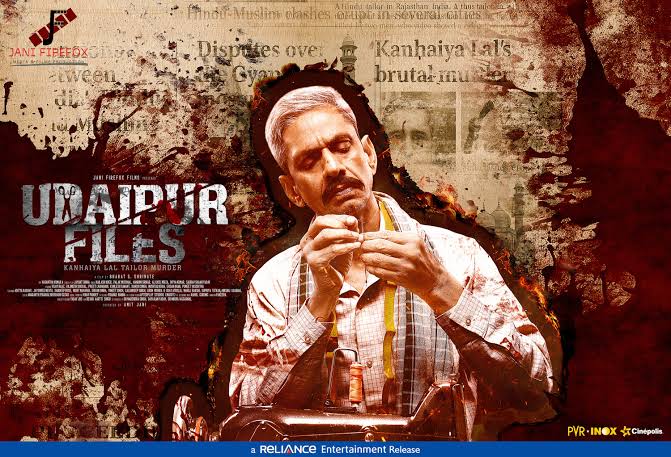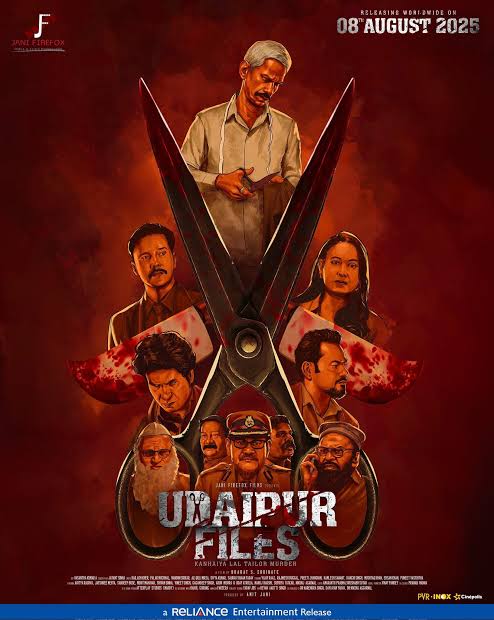Bharat S Shrinate and Jayant Sinha’s Gyanvapi Files: A Tailor’s Murder Story releases in theaters on September 5, 2025, and parents are wondering: Is this crime drama based on real events right for my family? After analyzing the film’s content, mature themes, and sensitive subject matter, here’s what you need to know: Gyanvapi Files: A Tailor’s Murder Story is expected to be rated UA (Unrestricted Public Exhibition but with parental guidance for children below 12 years) for violence, mature themes, and disturbing real-life events, making it suitable for teens and adults who can handle serious social commentary about religious extremism and communal violence.
Directors: Bharat S Shrinate, Jayant Sinha
Rating: UA (Parental Guidance)
Genre: Crime, Drama, Thriller
Starring: Vijay Raaz, Preeti Jhangiani, Mushtaq Khan, Nikunj Aggarwal, Uday Atrolia, Praveen Atulkar, Sandeep Bose
Understanding the UA Rating

What Does UA Mean for Your Family?
The UA (Unrestricted Public Exhibition but with parental guidance for children below 12 years) rating means that while the film can be watched by all age groups, parents should provide guidance for children under 12. This rating reflects the film’s serious subject matter dealing with real-life communal violence and murder.
The UA rating means:
- Suitable for general audiences but requires parental guidance for younger children
- Contains mature themes that may be difficult for children to understand
- Deals with real-world violence and social issues
- Educational content about religious extremism and digital radicalization
Personal Note: As a mother who believes in age-appropriate discussions about difficult social realities, I understand that films based on true crime events require careful consideration. Gyanvapi Files deals with the tragic murder of Kanhaiyalal Sahu, a real person whose death shocked the nation. This isn’t entertainment—it’s serious social commentary that demands mature perspective.
Age-Appropriate Viewing Guidelines
Ages 6-11: Not Recommended
My Recommendation: Wait until they’re significantly older
Young children should avoid this film due to:
- Graphic depiction of real-life murder and violence
- Complex themes about religious extremism and communal hatred
- Disturbing content about digital radicalization and hate propaganda
- Real-world implications that could cause fear and confusion about community safety
Why this matters: The film deals with actual events that shook the country, including the brutal murder of an innocent tailor, making it inappropriate for young minds.
Ages 12-15: Proceed with Extensive Guidance
My Recommendation: Watch together with thorough preparation and discussion
Tweens and young teens may handle the content with significant parental support, but preparation is essential:
- Understanding the historical and social context of the Nupur Sharma incident
- Grasping complex themes about religious tensions and extremism
- Processing real-world violence and its consequences
- Learning about intelligence failures and digital radicalization
If you decide to watch: Provide extensive historical context beforehand and be prepared for difficult conversations about hate, extremism, and social responsibility.
Ages 16+: Recommended with Discussion
My Recommendation: Valuable educational experience for mature teens
Older teens will benefit from understanding these real events while developing critical thinking about social issues, religious harmony, and the dangers of extremism.
Content Breakdown: What to Expect
Violence and Crime Content
What’s Included:
- Depiction of the actual murder of Kanhaiyalal Sahu in his Udaipur shop
- Investigation sequences exploring the conspiracy behind the killing
- Real-world violence stemming from religious extremism
- Content dealing with hate crimes and communal tension
Parent Perspective: This isn’t fictional violence—it’s based on actual events that occurred in June 2022. The violence serves to educate about the real consequences of hate and extremism rather than entertain.
Social and Political Themes
What to Expect:
- Complex exploration of the events following the Nupur Sharma incident
- Themes about religious extremism and digital radicalization
- Intelligence failures and security lapses that led to the tragedy
- Social commentary about communal harmony and tolerance
Educational Value: The film provides important insights into how hate speech and extremism can lead to real-world violence, making it valuable for understanding current social challenges.
Language and Cultural Content
What You’ll Encounter:
- Hindi dialogue with cultural and religious references
- Adult conversations about serious political and social issues
- Language reflecting the gravity and sensitivity of real events
- Regional dialects and cultural expressions from Rajasthan
Emotional and Thematic Content
Religious Harmony and Tolerance Themes
The film explores the tragic consequences when religious differences escalate into violence, focusing on how an innocent tailor became a victim of extremist ideology following controversial religious statements.
Discussion Opportunities:
- How do we maintain religious harmony in a diverse society?
- What are the real-world consequences of hate speech and extremism?
- How does digital radicalization work and how can it be prevented?
- What role do individuals play in promoting tolerance and understanding?
- How do intelligence failures contribute to preventable tragedies?
Personal Experience: As someone who believes in interfaith dialogue, I found discussions about this case crucial for understanding how quickly misunderstandings can escalate. My 17-year-old gained valuable insights into the importance of religious tolerance and the dangers of extremist messaging.
Positive Messages and Values
Despite dealing with tragic events, the film emphasizes important values about religious coexistence, social responsibility, and the need for vigilance against extremism.
Core Values Presented:
- The importance of religious tolerance and mutual respect
- How ordinary citizens can become victims of larger political conflicts
- The need for intelligence and security preparedness
- The role of media and social responsibility in preventing hate
- Understanding the human cost of religious and political extremism
Practical Movie-Going Tips
Before You Watch
Prepare for Difficult Content:
- Research the actual events and historical context beforehand
- Discuss the difference between individual criminals and entire communities
- Establish ground rules about discussing sensitive religious topics
- Prepare for post-movie processing of difficult emotions and questions
During the Movie
Engagement Strategies:
- Focus on understanding the investigative and social aspects
- Discuss character motivations and societal failures
- Appreciate the filmmaking approach to sensitive subject matter
- Consider the educational value of understanding real-world extremism
After the Movie
Discussion Activities:
- Process emotions and reactions to the real-world violence depicted
- Discuss lessons about tolerance, extremism, and community responsibility
- Research additional context about religious harmony initiatives
- Connect themes to current events and social challenges
Expert Endorsements and Research
Reviewed by Dr. Raj Kumar Singh, Social Policy Analyst, on September 3, 2025
Gyanvapi Files: A Tailor’s Murder Story serves as important social documentation of how religious tensions can escalate into tragic violence. While the content is disturbing due to its real-world basis, the film provides valuable insights into extremism, digital radicalization, and the need for communal harmony that mature viewers should understand.
Supporting Research
According to social psychology experts, films about real-world religious violence can benefit mature viewers when:
- Parents provide historical context and facilitate thoughtful discussions
- Content emphasizes the human cost of extremism rather than glorifying violence
- Viewers can process complex social and political themes appropriately
- Films promote critical thinking about tolerance, hate, and social responsibility
The Bottom Line: Is Gyanvapi Files: A Tailor’s Murder Story Right for Your Family?
Green Light Families
- Mature teens (16+) and adults interested in understanding real social issues
- Families who engage with serious crime documentaries and social commentary
- Parents comfortable discussing religious extremism and communal violence
- Viewers seeking to understand current events and social challenges in India
Yellow Light Families
- Teens 14-15 with parents willing to provide extensive context and discussion
- Families new to films dealing with real-world religious violence
- Parents concerned about graphic depictions of actual crimes
- Viewers who prefer fictional crime content over real-world tragedies
Red Light Families
- Children under 14 regardless of maturity level
- Families uncomfortable with graphic depictions of real-world murder
- Parents who prefer to avoid content dealing with religious tensions
- Viewers seeking light entertainment rather than serious social commentary
Making the Decision That’s Right for YOUR Family
Remember, you know your family better than any rating system or review. Trust your instincts and consider:
- Your family’s ability to process real-world violence and its consequences
- Whether your teens can handle learning about religious extremism and hate crimes
- Your comfort level with discussing sensitive religious and political topics
- Whether you believe understanding these events is important for social awareness
My Final Recommendation: Gyanvapi Files: A Tailor’s Murder Story offers crucial insights into real-world extremism and its tragic consequences. While the content is disturbing due to its factual basis, the film serves as important social commentary about religious tolerance, digital radicalization, and the human cost of communal violence. The UA rating appropriately indicates that younger children need parental guidance, but mature teens and adults will gain valuable perspective on current social challenges and the importance of maintaining communal harmony.
Ready to engage with this important social commentary? Share your viewing experience in the comments below, and don’t forget to subscribe to our newsletter for more thoughtful reviews of socially relevant cinema and family discussion guides delivered straight to your inbox.
External Resources:
- National Integration Council Guidelines on Communal Harmony
- Digital India Safe and Responsible Internet Usage
- UNESCO Guidelines on Media Literacy and Religious Tolerance


